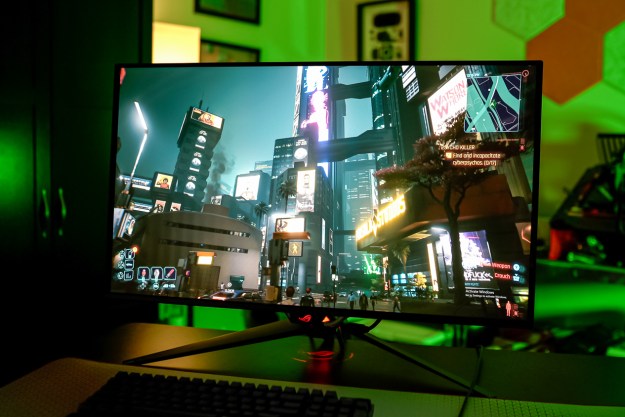
- Fantastic color coverage
- Robust list of features
- BFI support at 120Hz
- Speedy refresh rate
- Beautiful glossy coating
- No pivot with stand
- Some picture modes struggle with brightness and color
- Expensive
Asus came out of the first wave of OLED gaming monitors as the unofficial champion, sitting on the list of the best gaming monitors with entries like the PG27AQDM and PG42UQ. Now, we have the second wave of OLED gaming monitors, starting with the PG32UCDM. And, out of the gate, Asus may have already secured a top slot.
The PG32UCDM is the first QD-OLED monitor from Asus, and it finally delivers the 4K resolution that gamers have been begging for in an OLED display. The bells and whistles may not justify the high price for everyone, but it’s a fantastic monitor through and through.
Video review
Asus ROG Swift PG32UCDM specs
| Asus ROG Swift PG32UCDM | |
| Screen size | 31.5 inches |
| Panel type | Third-gen OD-OLED |
| Resolution | 3,840 x 2,160 |
| Peak brightness | 1,000 nits (HDR), 450 nits (SDR) |
| HDR | DisplayHDR True Black 400 |
| Local dimming | 8,294,400 zones |
| Contrast ratio | 1,500,000:1 |
| Response time | 0.03ms (GtG) |
| Refresh rate | 240Hz |
| Curve | N/A |
| Speakers | N/A |
| Inputs | 2x HDMI 2.1, 1x DisplayPort 1.4 |
| Ports | 3x USB 3.2 Gen 2 Type-A, 1x USB 3.2 Gen Type-C w/ 90W power delivery |
| List price | $1,300 |
A gamer’s design
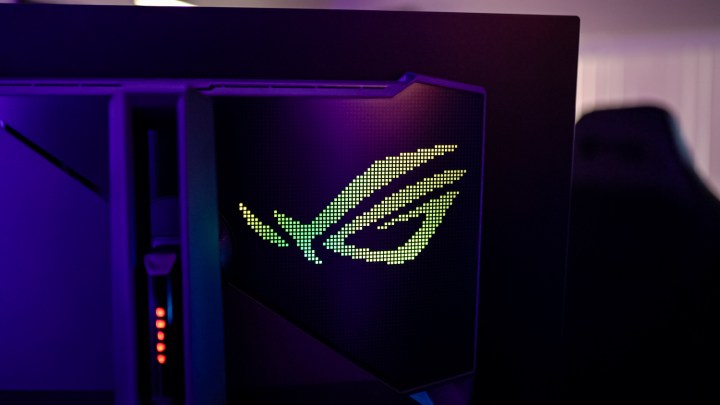
Asus isn’t breaking the mold with the PG32UCDM, and it doesn’t need to. Like most ROG monitors, you get a massive tripoint stand. It’s big, but the stand doesn’t protrude too far out in front of the monitor. The display itself is centered a little closer to the front of the stand so it doesn’t feel like you’re wasting too much desk space. This monitor still takes up a decent chunk of desk space with the included stand, but at least you aren’t dealing with several inches of stand before you get to the actual screen.
The included stand features solid adjustment points, including 25 degrees of tilt, 30 degrees of swivel, and just shy of four-and-a-inches of height adjustment. As you probably guessed, you don’t have to use the included stand, as Asus includes a 100mm x 100mm VESA mount. You might want to take advantage of that, too, as the included stand doesn’t support any pivot.
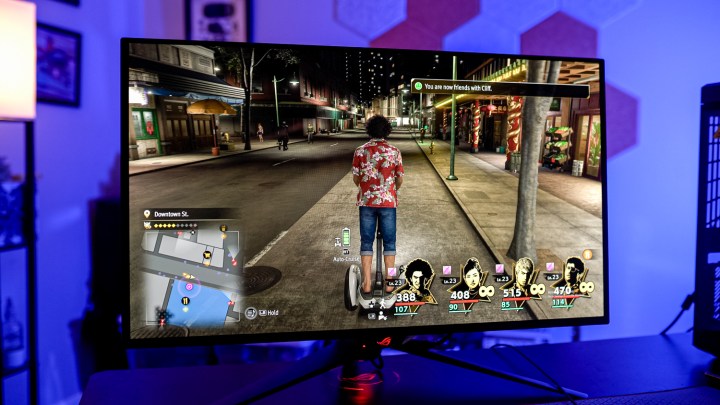
Asus takes advantage of the bit of height the stand provides to cast down an ROG logo on your desk. This isn’t a new feature, but it still looks super cool. Elsewhere, you’ll find RGB on the back of the stand with some Swift branding, as well as an ROG logo that illuminates in a grid. You can control that through the on-screen display or with Asus Aura Sync.
The PG32UCDM is quite a bit thicker than last year’s ROG Swift PG27AQDM, and that’s mainly due to this chunky plastic shell on the back of the display. This houses a custom heat sink that allows the monitor to be cooled without fans. It’s totally passive here. You don’t need to contend with any noise, and in my testing, the monitor never reached a point of even being warm.
Justifying the premium
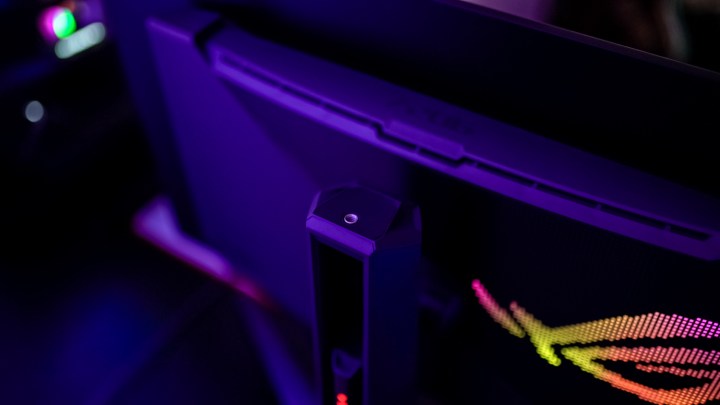
The PG32UCDM is in direct competition with the Alienware 32 QD-OLED. Both monitors use the same panel, but the Asus comes in at $1,300, while Alienware charges $1,200. Asus justifies the higher price with a robust list of features.
Asus packs a ton of extra goodies into its monitors that add up to a lot of value. For instance, there’s a quarter-inch thread on top of the stand, so you can mount a tripod head and a camera. There’s a built-in KVM switch so you can use your peripherals across multiple sources. You can adjust your picture settings on the desktop through Asus Display Widget Center. And there’s an integrated USB hub with three USB 3.2 Gen 2 Type-A ports and a USB-C capable of 90 watts of power delivery. The power delivery mode caps the brightness of the display at 90W, but you can turn it down to 65W without impacting brightness output.
Any of these features on their own wouldn’t mean much, but add them together, and there’s a ton of value in this display. You can get this same panel elsewhere, but Asus really does go above and beyond to make its version of this monitor stand out in an increasingly crowded market.
The big deal here for the PG32UCDM is that it’s covered by Asus’ new warranty. Just like Alienware, Corsair, and MSI, Asus now offers a three-year warranty on its OLED monitors that covers burn-in and any bright or dark dots on the screen. A three-year warranty has been a feather in Alienware’s cap for the past couple of years, and now Asus is matching it.
How Asus flexes
Asus tucks the ports under the display, allowing you to feed the cables through the stand and keep your connections out of sight. There’s an integrated USB hub with three USB-A ports and a single USB-C port, along with two HDMI 2.1 connections and a a single DisplayPort 1.4.
As mentioned, you can use Display Widget Center to control the monitor on your desktop, but the on-screen display is excellent. There’s this little lip on the front of the monitor, and you’ll find the joystick behind it — no hunting around behind the display.

In the on-screen display, you have a ton of options between different picture modes, six-axis color adjustment, and settings for Adaptive Sync, but I want to highlight two settings in particular. First, in HDR, Asus allows you to adjust the brightness. This will change the color response, but most monitors lock you out of brightness adjustment when you turn on HDR. Here, there’s an option.
More important is Extreme Low Motion Blur, or ELMB. You may know this as Black Frame Insertion, or BFI, which improves motion clarity if your frame rate is low. It works here, but with a few caveats. You can’t be in HDR or use variable refresh rate, and you have to set the monitor to 120Hz.
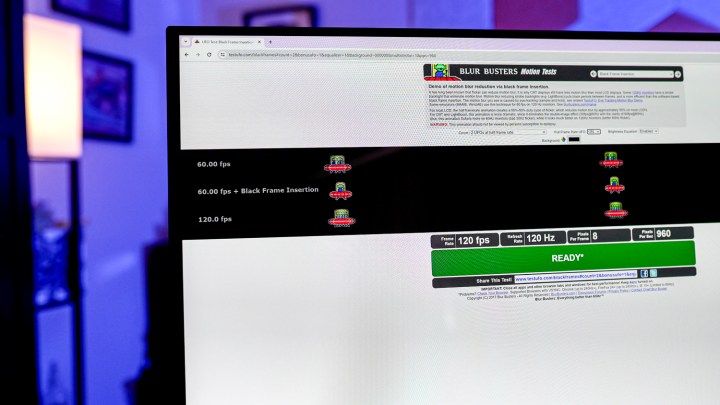
Where is this relevant? Well, if you’re running a game and can’t hit 120Hz, you can cap your frame rate at 60 frames per second (fps), and with ELMB activated, you’ll get the motion clarity of 120Hz. To be clear, you don’t get the smoothness of a game running at 120 fps — it still feels like 60 fps — but there’s a lot less blur with ELMB turned on.
It’s a great feature to have, particularly with console games that will stay locked at 60 fps, but I imagine most people will pair this high-end monitor with a high-end PC, and in that situation, you should run the monitor at its full refresh rate. Turning on ELMB not only locks you out of HDR, but it also disables adaptive sync and massively lowers the brightness of the display.
Some of the best color we’ve seen
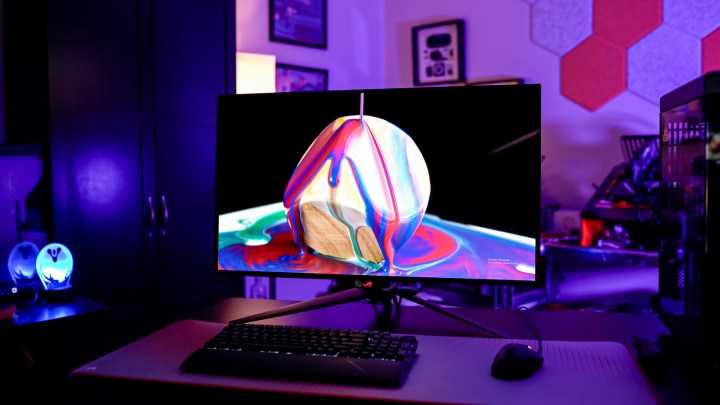
We’ve seen the panel on the PG32UCDM before, so I knew what to expect going into this review. It’s third-gen QD-OLED, fit with great brightness, perfect contrast, and solid color accuracy. And Asus also gives you a lot of options to tweak your picture quality.
Starting off, you have great color coverage. In the User Mode, I measured 100% of sRGB, 98% of DCI-P3, and 93% of AdobeRGB. That AdobeRGB result is particularly impressive, showing that there’s great color coverage on this display. In sRGB mode, I measured a color error of just over 1. That’s not quite as good as the Alienware 32 QD-OLED, but it’s still great for out of the box color.
With the color options built into the display, there’s definitely room to adjust the color more. This isn’t the best accuracy I’ve seen out of the box, but it’s certainly not bad, either. Naturally, your mileage will vary based on what picture profile you choose, but we’ve seen this same panel reach a color error of around 0.4.

The metric everyone cares about with an OLED display, though, is brightness. In SDR, I measured a peak brightness of 436 nits, which is just a stone’s throw away from the 450 nits Asus claims. HDR is what really matters here, though.
Asus claims a peak brightness of 1,000 nits, and I know this panel can reach it. But I wasn’t able to get there with the picture presets. There are four HDR modes included with the monitor, and the Console HDR settings allowed me to hit just over 800 nits for a 4% window. That matches the Alienware 32 QD-OLED for the same window size, but Asus fell a bit short for a 1% window with a result of 947 nits. In practice, a difference of 50 or so nits really doesn’t matter at this level.
This is a super bright monitor. It looks even brighter considering the perfect black levels of OLED. You won’t have any problems working off of it in a brightly lit room, with the highest brightness being absolutely searing if you pull the shades down. In a dark environment, I wasn’t even comfortable pushing the brightness above halfway. Still, we’re a little short of a 1,000 nits, at least with the HDR presets.
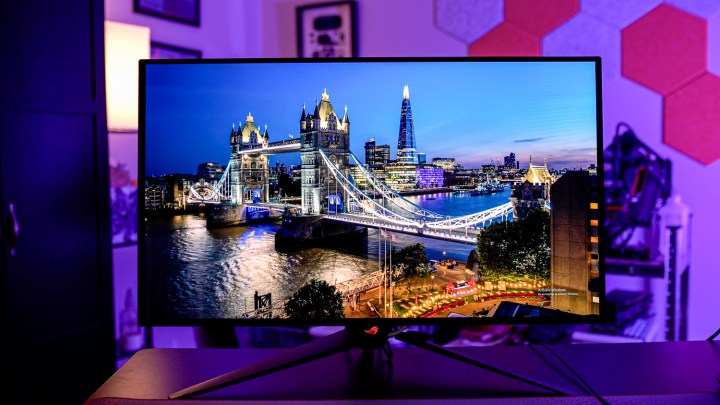
If you’re looking for peak brightness, you should use the Console HDR preset. Asus includes four HDR modes, but the company tells me that the Console HDR mode is what will offer the maximum light output.
Regardless, this monitor is still super bright, and it looks fantastic. For brightly lit rooms, the bigger element to overcome is the glossy screen, not the brightness of the display. It looks like Asus is using some sort of coating to keep reflections at bay, but any harsh, direct light still shows up pretty clearly.
No surprise, great gaming
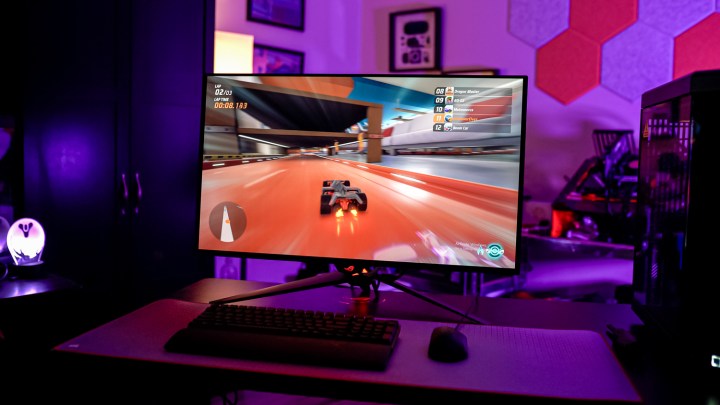
Gaming on the PG32UCDM is incredible, but that probably doesn’t come as a surprise. You get all the things here — there’s a 240Hz refresh rate, FreeSync Premium Pro and G-Sync Compatible certification, support for HDR10 and Dolby Vision for consoles, and the insane response times of OLED.
You know you’re going to get a great gaming experience, but for me, what really stands out is this form factor. There’s something so perfect about a 4K monitor at 32 inches where you’re getting a sweet spot of pixel density at around 140 pixels per inch. The monitor looks super sharp, but it’s also big enough that you’re able to get immersed in your games.
With the default stand, it fills your view. You’re not sucked in quite as much as some massive monitor like the Samsung Odyssey OLED G8, but the display is still large enough to immerse you in those cinematic titles like Alan Wake 2 and Cyberpunk 2077. The stand surprisingly plays a role here, too. The screen is positioned closer to you with the included stand, so you feel like you’re right in the action.
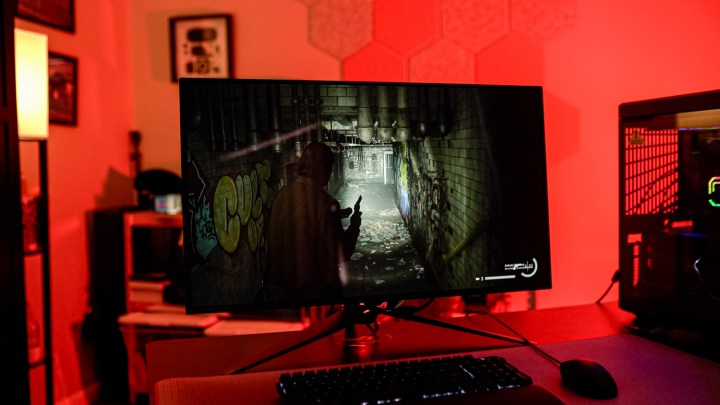
You’re getting the best of both worlds here. A 240Hz refresh rate with the low response times of OLED can make a big difference in motion clarity for those more competitive games like Counter-Strike 2 and Rainbow Six: Siege. This is the Swiss Army knife of gaming monitors, giving you access to all of the gaming experiences you could want without sacrificing in any direction.
Consoles are at home here, too, not only due to the 4K resolution and HDMI 2.1 ports, but also thanks to support for Black Frame Insertion at 120Hz. Both the PlayStation 5 and Xbox Series X support 120Hz output, giving you the option to get a bit of extra motion clarity on those games running at 60 fps consistently.
There isn’t an area in gaming where it feels like PG32UCDM struggles. Monitors like the Alienware 27 QD-OLED lean heavier on motion smoothness, while the Odyssey OLED G9 leans on immersion. The PG32UCDM can do everything. It’s superfast for competitive games, big enough to suck you in for cinematic titles, and packed with features that make console gaming better.
The burn-in section
The risk of burn-in is omnipresent with OLED monitors, especially after significant desktop use. You shouldn’t fear it, but it’s a factor you need to consider if you plan on picking up an OLED gaming display. Thankfully, it’s even less of a concern with the PG322UCDM.
As mentioned, you get a three-year warranty with this display that covers burn-in, but more importantly, Asus includes a pixel-cleaning feature with reminders you can set after every two, four, or eight hours of use, as well as an auto-dimming feature for static elements like logos. There’s also a screensaver built into the display that will kick in by default.
You have a lot of options here to keep the screen looking great, as well as that three-year warranty in your back pocket in case anything goes wrong. Still, this is a gaming monitor, so it’s best to use it to play games, not sit on your desktop or watch TV all day. That shouldn’t come as a surprise.
A healthy contender
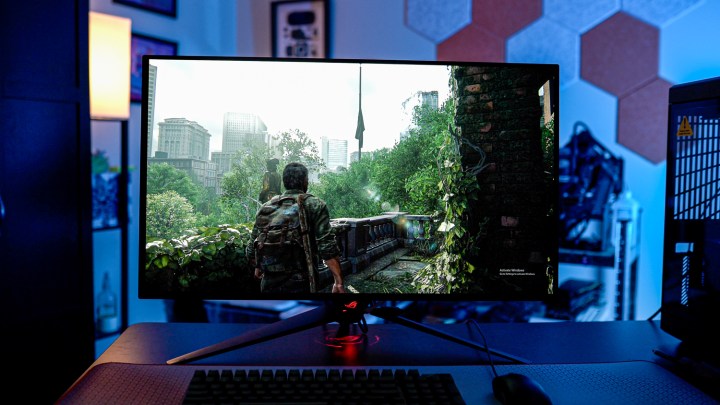
The big question for the PG32UCDM is if it can justify a premium over the Alienware counterpart and the upcoming competition from MSI and Gigabyte. And it does. It matches Alienware’s monitor, both in quality and support, and it goes further with an excellent stand and a world-class set of features.
For an extra $100, I would buy the Asus monitor every time. My only lingering question is if that will be the difference for buyers. Alienware has a little bit of a head start in the market, and in the past, I’ve seen a lot more Alienware monitors on sale than Asus ones. Ultimately, you’ll need to make that call depending on pricing, keeping in mind that Asus comes out slightly ahead with its set of features.





